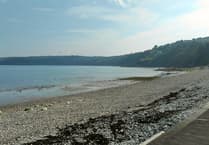I thought this week we might look at some more of the named streets of Douglas from the book written by my old friend Stuart Slack from the late 1990s.
Last time we reached D in the alphabet so starting with E… not really a street but Edward Pier as it is known in abbreviated form is named such after King Edward VIII, it was virtually an extension of the old Red Pier and was opened in May 1936.
Empress Drive was originally intended to be called Athol Terrace but was renamed in celebration of Queen Victoria’s title Empress of India. Farmhill, where I live commenced in the 1980s and is one of the larger private developments in the town occupying most of the former farmland.
Most of the street names relate to nearby locations with five Clybanes after the adjacent farm, five Manors and six Farmhills after Farmhill Manor.
It was formerly known as Ballaquirk and was the property of the Quirk family from about 1430 to the middle of the 18th century when it passed to Receiver-General Senhouse Wilson.
In my time the property was owned by the late William Scholl and his wife Susan.
They were exceptionally generous to many good causes and whenever I called at the lovely house I always received a warm welcome.
A good friend of mine, the late Freddy Joughin, looked after the grounds over an extended period.
Back to Farmhill Hilltop Rise and view were named after nearby nurseries, Hampton Court and Grove after the family who farmed Ballabunt above the Cooil for many generations.
Springfield after the nearby mansion house and Oakhill and Richmond after the hills heading South.Vicarage Mews after the adjacent Vicarage Road on which is sited the former Braddan Vicarage.
Other addresses include Meadowbrook Gardens, Rosebank and Woodlands View.
Farrant Street built in the 1880s was named after the family of the same name.
Those of us of a certain age will recall Fayle’s Yard to be found on the south side of Well Road Hill.
This had personal connections to me as I went out with Jaqueline Fayle for three years before she was killed in a road traffic accident aged 18 in May 1975.
Her mum was Alice Fayle who was so very kind to me and my family after the tragedy and her late husband Jackie had operated a fruit and vegetable business from the yard bearing the family name. Farvane Close, Link and Park at Anagh Coar are named after the Manx for buttercup.
Fenella Avenue in Willaston was named after a fictional character in the novel Peveril of the Peak by Sir Walter Scott, much of which was based on the island and particularly in Peel Castle.
Finch Hill, Road and other uses of this name date from the early years of the 17th century when Patrick Vinch purchased a large tract of the area.
The name evolved to Finch during the 18th century.
Fort Anne was built in the 1790s by the notorious Thomas ‘Buck’ Whaley after his mother and was a prominent Douglas landmark for almost 200 years before being demolished in 1979.
Before its life as a hotel it was owned by, among others, Sir William Hillary, founder of the Royal National Lifeboat Institution, who was the main motivator and subscriber to the building of the Tower of Refuge. He sold Fort Anne in 1846 and it was later turned into a successful hotel.
I remember my cousin John Cretney operating a disco in the Port hole bar which comprised, if I remember correctly, seating in a similar form to rowing boats!
In the same area Fort William with magnificent views across the harbour first had properties for sale from around 1849 adjoining Fort Anne.
These days we have 1886, a club and restaurant operation from the converted former head post office in Regent Street but does anyone remember 1449?
Over the entrance of the former Happy Days garage on Queen’s Promenade could be seen 14-49.
The garage was built by Mr Foden of the famous firm of wagon manufacturers in 1924 the year that his nephews, the brothers Edwin and Kenneth Twemlow, won the Lightweight and Junior TT races within a few days of each other.
The racing number of Ed’s machine was 14 and that of Ken 49.
Frederick Street, Edward Lane, Senna Road and others formed part of a large clearance and redevelopment for the Chester Street car park.
I remember Felice’s ice cream factory being in the area which was named after the father of Frederick La Mothe Gelling, a Castletown advocate who purchased it in 1839 prior to redeveloping the area and whose father with the same name died the previous year.
Garden City to the west of Bray Hill was earmarked for development in the 1920s.
It was laid out in the following decade, more or less, in concentric circles with the present Port e Chee Avenue, which overlooks the farm of the same name described as outer circle, High View Road as centre circle and Inner Circle remains as such. I always think the name is very appropriate for the town planning proposals of the time more generally.
Glen Falcon Road was cut-through in the 1870s to separate the lower triangle bounded by Broadway and Derby Road from the remainder of the Woodbourne estate following the purchase of the former by William Okell who at the time operated the Falcon brewery at Falcon Cliff.
Okell built a substantial residence on his parcel of land which he named ‘Glen Falcon’ and utilised the water from the stream that ran through the glen for the brewing of Okell’s ale when he eventually transferred his brewery to a site opposite the house.
The house was removed in 1948 to facilitate the widening of Broadway and in 1951 the glen was dedicated to our national poet, TE Brown, with a plaque bearing one of his best known quotations ‘a garden is a lonesome thing’.
Governor’s Bridge was originally known as Heywood’s or the Deemster’s Bridge after Deemster John Joseph Heywood who owned Bemahague, now Government House, in the early years of the 1800s.
It gained its present name as a convenient marker for the TT when the TT course was amended to include the bridge in 1920.
I have to say I had no idea about that! Some TT commentators at the time Stuart wrote the book and since continue to use the term Governor’s Dip.
There are two interesting old milestones in the ‘dip’.
Both indicate ‘two miles from Douglas’, one of which is a sandstone set which was laid out on the Douglas to Ramsey road, whilst the other is a name stone set into the actual bridge.
Obviously the ‘dip’ is not in everyday use but is important to those with a close connection with the TT.
Twice I have been involved helping families with a loved ones last wish after obtaining permission.
Once to allow a funeral procession of a long standing marshal to use the dip and once to enable the ashes of a former senior official of the TT and his wife who had also given dedicated service to be scattered adjacent.



.png?width=209&height=140&crop=209:145,smart&quality=75)
